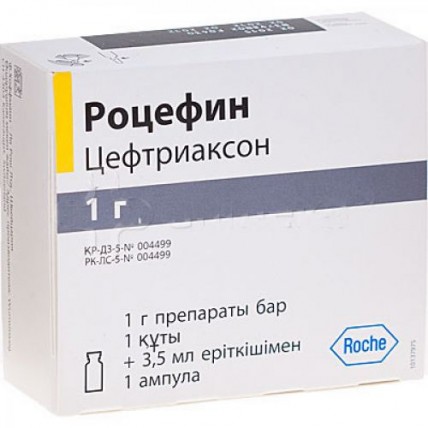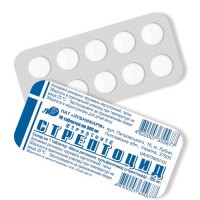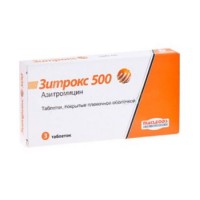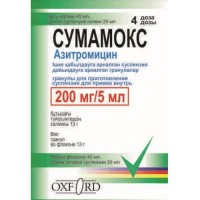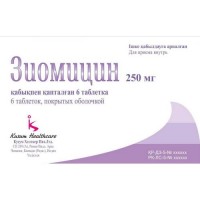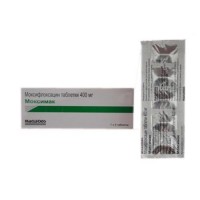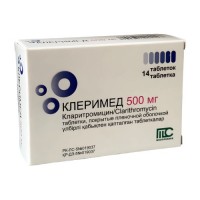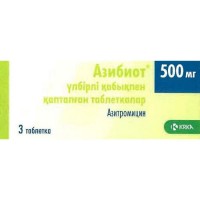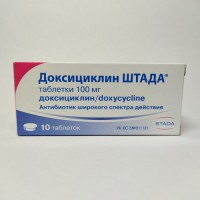Rocephin 1g of sol. 3.5 ml of a 1% solution of lidocaine 1's powder for intramuscular injection
- $42.70
The instruction for medical use
of Rotsefin Torgovoye medicine a name
Rotsefin
Mezhdunarodnoye the unlicensed
name Tseftriakson Lekarstvennaya a form
Powder for intramuscular injections of 500 mg, 1 g complete with solvent (1% lidocaine solution for injections)
Structure
One bottle contains
active agent – a tseftriakson of sodium salt of 0.5966 g, 1.193 g (it is equivalent to a tseftriakson according to 0:50 g, 1 g)
Solvent:
1 ml of solution contains
active agent – lidocaine of a hydrochloride of 10.66 mg (it is equivalent to lidocaine of 10.0 mg),
excipient: water for injections.
The description
Powder from white till yellowish-orange color.
The restored solution: transparent liquid from chartreuse till orange-yellow color.
Solvent: transparent colourless solution.
Pharmacotherapeutic group
Beta laktamnye antibacterial drugs other. Cephalosporins of the third generation.
The code of automatic telephone exchange J01DD04
the Pharmacological
Pharmacokinetics Pharmacokinetics properties of a tseftriakson has nonlinear character. All key pharmacokinetic parameters based on the general concentration of drug except for elimination half-life, depend on a dose.
The maximum concentration in plasma after single intramuscular introduction of 1 g of drug makes about 81 mg/l and is reached within 2-3 hours after introduction. The areas under a curve concentration in plasma – time after intravenous and intramuscular administration are identical. It means that the bioavailability of a tseftriakson after intramuscular introduction is 100%.
The volume of distribution of a tseftriakson is 7-12 l.
After introduction in a dose of 1-2 g tseftriakson well gets into fabrics and liquids of an organism. Within more than 24 hours of its concentration much more exceed the minimum overwhelming concentration for the majority of causative agents of infections more than in 60 fabrics and liquids (including in lungs, heart, bilious ways, a liver, tonsils, a middle ear and mucous a nose, bones and also spinal, pleural and synovial liquids and a secret of a prostate).
After intravenous use tseftriakson quickly gets into cerebrospinal fluid where bactericidal concentration concerning sensitive microorganisms remain within 24 hours. Tseftriakson reversibly contacts albumine, and extent of binding decreases with concentration growth, decreasing, for example, from 95% at concentration in plasma less than 100 mg/l to 85% at concentration of 300 mg/l. Thanks to smaller concentration of albumine in an intercellular lymph, the share of a free tseftriakson in it is higher, than in plasma.
Tseftriakson gets through the inflamed meninx at children, including newborns. In 24 hours after intravenous administration in doses of 50-100 mg/kg of body weight (to newborns and babies, respectively) concentration of a tseftriakson in cerebrospinal fluid exceed 1.4 mg/l. The maximum concentration in cerebrospinal fluid is reached approximately in 4 hours after intravenous administration and makes, on average, 18 mg/l. In bacterial meningitis the average concentration of a tseftriakson in cerebrospinal fluid makes 17% of concentration in plasma, in aseptic meningitis - 4%. At adult patients with meningitis in 2-24 hours, after introduction of a dose of 50 mg/kg of body weight, concentration of a tseftriakson in cerebrospinal fluid many times over exceed the minimum overwhelming concentration for the most widespread causative agents of meningitis.
Tseftriakson passes through a placental barrier and in small concentration gets to breast milk.
Tseftriakson is not exposed to system metabolism, and turns into inactive metabolites under the influence of intestinal microflora.
The general plasma clearance of a tseftriakson is 10-22 ml/min. The renal clearance equals 5-12 ml/min. of 50-60% of a tseftriakson 40-50% are removed in not changed view with urine, and - in not changed view with bile. Elimination half-life of a tseftriakson makes about 8 hours at adults.
The pharmacokinetics at special groups of patients
At patients with a renal failure or a liver pharmacokinetics of a tseftriakson changes slightly, only small increase in elimination half-life is noted. If only function of kidneys is broken, removal with bile increases if only function of a liver is broken, removal through kidneys increases.
Patients are more senior than 75 years
At persons 75 years elimination half-life of a tseftriakson, on average, in two or three times more, than at adults of young age are more senior.
Children
At newborn children okolo70 the % of a dose is removed through kidneys. Babies in the first 8 days have lives, on average, in two or three times more, than at adults.
The pharmacodynamics
Bactericidal activity of a tseftriakson is caused by suppression of synthesis of cellular membranes. In vitro tseftriakson possesses a broad spectrum of activity concerning gram-negative and gram-positive microorganisms. Vysokoustoychiv to the majority β-лактамаз (as penicillinases, and tsefalosporinaz), developed by gram-positive and gram-negative bacteria.
Tseftriakson is usually active concerning the following microorganisms:
Gram-positive aerobes:
Staphylococcus aureus (metitsillinochuvstvitelny), Staphylococci coagulase-negative, Streptococcus pyogenes (ß - hemolytic, groups A), Streptococcus agalactiae (ß - hemolytic, groups B), ß - hemolytic streptococci (groups And, C), Streptococcus viridans, Streptococcus pneumoniae.
Note. Metitsillinoustoychivye Staphylococcus spp. rezistentna to cephalosporins, including to a tseftriakson. As a rule, Enterococcus faecalis, Enterococcus faecium and Listeria monocytogenes are also steady.
Gram-negative aerobes:
Acinetobacter lwoffi, Acinetobacter anitratus (mainly, A. baumanii) *, Aeromonas hydrophila, Alcaligenes faecalis, Alcaligenes odorans, alkaligenopodobny bacteria, Borrelia burgdorferi, Capnocytophaga spp., Citrobacter diversus (including C. amalonaticus), Citrobacter freundii *, Escherichia coli, Enterobacter aerogenes *, Enterobacter cloacae *, Enterobacter spp. (other) *, Haemophilus ducreyi, Haemophilus influenzae, Haemophilus parainfluenzae, Hafnia alvei, Klebsiella oxytoca, Klebsiella pneumoniae **, Moraxella catarrhalis (before Branhamella catarrhalis), Moraxella osloensis, Moraxella spp. (other), Morganella morganii, Neisseria gonorrhea, Neisseria meningitidis, Pasteurella multocida, Plesiomonas shigelloides, Proteus mirabilis, Proteus penneri *, Proteus vulgaris *, Pseudomonas fluorescens *, Pseudomonas spp. (other) *, Providentia rettgeri *, Providentia spp. (other), Salmonella typhi, Salmonella spp. (netifoidny), Serratia marcescens *, Serratia spp. (other) *, Shigella spp., Vibrio spp., Yersinia enterocolitica, Yersinia spp. Other.
* Some isolates of these types are resistant to a tseftriakson, mainly, owing to education laktamaz, coded by chromosomes.
** Some isolates of these types are steady owing to formation of a number plazmido-mediated laktamaz.
Note. Many strains of the above-stated microorganisms polyresistant to other antibiotics, such as aminopenicillin and ureidopenicillin, cephalosporins of the first and second generation and aminoglycosides, are sensitive to a tseftriakson.
Treponema pallidum is sensitive to a tseftriakson of in vitro and in experiments on animals. Clinical trials show what tseftriakson has good efficiency concerning primary and secondary syphilis. Behind very small exceptions, clinical P. aeruginosa isolates are resistant to a tseftriakson.
Anaerobe bacterias:
Bacteroides spp. (zhelchechuvstvitelny) *, Clostridium spp. (except for C. difficile), Fusobacterium nucleatum, Fusobacterium spp. (other), Gaffkia anaerobica (before Peptococcus), Peptostreptococcus spp.
* Some isolates of these types are resistant to a tseftriakson because of education β-лактамаз.
Note. Many strains of the β-lactamazoforming Bacteroides spp. (in particular, B. fragilis) are steady. Also Clostridium difficile is steady.
The indications
of the Infection caused by activators, sensitive to the drug Rotsefin:
- sepsis
- meningitis
- a disseminate disease of Lyme (early and late stages of a disease)
- infections of abdominal organs (peritonitis, infections of biliary tract and digestive tract)
- infections of bones, joints, soft tissues, skins, wound fevers
- infections at patients with the weakened immunity
- infections of kidneys and urinary tract
- respiratory infections, especially pneumonia, infections of ENT organs
- genital infections, including gonorrhea
- preoperative prevention of infectious complications.
The route of administration and doses
the Standard dosage
Adults and children are more senior than 12 years: on 1-2 g once a day (each 24 hours).
In hard cases or in infections which causative agents have only moderate sensitivity to a tseftriakson it is possible to increase a daily dose to 4 g.
Duration of treatment depends on a course of the disease. As well as always at antibiotic treatment, administration of the drug Rotsefin should be continued the patient within at least 48-72 hours after normalization of temperature and confirmation of an eradikation of the activator.
Combination therapy
synergism between the drug Rotsefin and aminoglycosides concerning many gram-negative bacteria Is shown. In spite of the fact that the increased efficiency of such combinations is not always predictable, it should be meant in heavy, life-threatening infections, such as the caused Pseudomonas aeruginosa. Because of physical incompatibility of a tseftriakson and aminoglycosides they should be entered separately in the doses recommended for them.
Patients with an abnormal liver function have no need to reduce a dose on condition of absence of renal failures.
Patients with a renal failure have no need to reduce a dose on condition of absence of abnormal liver functions. The daily dose of the drug Rotsefin should not exceed 2 g only in cases of a renal failure with clearance of creatinine less than 10 ml/min.
At a combination of a heavy renal and liver failure it is regularly necessary to define concentration of a tseftriakson in plasma and if necessary to adjust its dose.
The patient who is on dialysis, additional administration of drug after dialysis is not required. It is necessary to control, however, concentration of a tseftriakson in serum regarding possible dose adjustment as clearance rate at these patients can decrease.
Patients of advanced and senile age
Usual doses for adults, without adjustments for age.
Children
Newborns, babies and children are younger than 12 years
When prescribing the drug Rotsefin once a day it is recommended to adhere to the following modes of dosing:
newborns (up to 14 days) - 20-50 mg/kg of body weight once a day. The daily dose should not exceed 50 mg/kg of body weight. When determining a dose it is not necessary to do differences between the full-term and premature children.
Rotsefin is contraindicated to newborns (≤8 days) who already appoints or supposes intravenous treatment kaltsiysoderzhashchy solutions, including long kaltsiysoderzhashchy infusions, for example, at parenteral nutrition because of risk of formation of precipitated calcium superphosphates of calcic salts of a tseftriakson. Newborns, babies and children of younger age (from 15 days to 12 years): 20-80 mg/kg of body weight once a day.
To children with body weight over 50 kg appoint doses for adults.
Meningitis
In bacterial meningitis at babies and children of younger age treatment begin with a dose 100 mg/kg (but no more than 4 g) 1 time a day. After identification of the activator and determination of its sensitivity the dose can be reduced respectively.
The best results in a spotted fever were achieved lasting treatment of 4 days, in the meningitis caused by Haemophilus influenzae - 6 days, Streptococcus pneumoniae - 7 days.
Lyme's disease
of 50 mg/kg (the highest daily dose - 2 g) to adults and children once a day within 14 days.
The gonorrhea (caused penitsillinazoobrazuyushchy and penitsillinazo - not forming strains)
Single intramuscular introduction of 250 mg of the drug Rotsefin.
Prevention of postoperative infections
Depending on degree of infectious risk is entered by 1-2 g of the drug Rotsefin once in 30-90 min. prior to operation. At operations on thick and a rectum well proved simultaneous administration of the drug Rotsefin and one of 5 nitroimidazoles, for example, of an ornidazol.
Introduction
by the General rule has to be use of solutions right after preparation.
The prepared solutions keep the physical and chemical stability within 6 hours at the room temperature (or within 24 hours at a temperature of 2-8 ºC). Depending on concentration and duration of storage color of solutions can vary from pale yellow to amber. Coloring of solution does not affect efficiency or tolerance of drug.
For an intramuscular injection of 500 mg of the drug Rotsefin dissolve in 2 ml, and 1 g - in 3.5 ml of 1% of solution of lidocaine and enter deeply into rather big muscle (buttock). It is recommended to enter no more than 1 g into the same muscle.
The solution containing lidocaine cannot be entered intravenously.
Solutions of the drug Rotsefin cannot be mixed or added to the solutions containing other antimicrobial drugs or other solvents because of possible incompatibility.
Side effects
- a dieback, allergic dermatitis, an itching, urtikarny rash, hypostases
- not properly executed chair or diarrhea, nausea, vomiting, stomatitis, a glossitis, precipitation of calcic salts of a tseftriakson in a gall bladder, increase in levels of enzymes of a liver
- an eosinophilia, a leukopenia, a granulocytopenia, hemolytic anemia, thrombocytopenia
- a headache, dizziness
- an oliguria, increase in level of creatinine of plasma
- fever, a fever, anaphylactic reactions
- genital mycosis
Interaction with calcium ions
Are described separate fatal cases of formation of precipitated calcium superphosphates in lungs and kidneys by results of an autopsy research at the newborns receiving Rotsefin and kaltsiysoderzhashchy solutions. At the same time one venous access was in some cases used, and formation of precipitated calcium superphosphates was observed directly in a system for intravenous administration. At least, one case from the death is also described, at various venous accesses and to various time of administration of the drug Rotsefin and calcium - the containing solutions. At the same time by results of an autopsy research precipitated calcium superphosphates were not found in this newborn. Similar cases were observed only at newborns.
It was reported about sporadic cases of an agranulocytosis (& lt, 500/ml), the most part from them was observed after 10 days of treatment and against the background of purpose of total doses more than 20 g.
It was reported about sporadic cases of serious reactions (multiformny erythema, Stephens-Johnson's syndrome, a toxic epideramlny necrolysis (Lyell's disease)).
Very exceptional cases of pseudomembranous colitis are described (& lt, 0.01%) and in kidneys, mainly, at children 3 years which were receiving or high daily doses of drug (more than 80 mg/kg a day), or cumulative doses more than 10 g and also having accessory factors of risk (liquid consumption restriction, a bed rest, etc.) are more senior than disturbances of blood clotting and also formation of concrements. Formation of concrements in kidneys can proceed asymptomatically or clinically be shown, can lead to a renal failure. This undesirable phenomenon has reversible character and disappears after the therapy termination by the drug Rotsefin.
The intramuscular injection without use of lidocaine is painful.
In rare instances at the Rotsefin drug treatment at patients false positive results of test of Koombs can be noted. As well as other antibiotics, Rotsefin can yield false positive result of test on a galactosemia. False positive results can be received also when determining glucose in urine by not fermental methods therefore during therapy by the drug Rotsefin the glucosuria if necessary needs to be determined only by a fermental method.
Contraindications
- hypersensitivity to cephalosporins and penicillin
- hypersensitivity to solvent – lidocaine
- a hyperbilirubinemia at newborn and premature (tseftriakson can force out bilirubin from communication with seralbumin, increasing risk of developing bilirubinovy encephalopathy at such patients)
- newborns (≤28 days) which already appoints or supposes intravenous treatment kaltsiysoderzhashchy solutions including long kaltsiysoderzhashchy infusions, for example, at parenteral nutrition, because of risk of formation of precipitated calcium superphosphates of calcic salts of a tseftriakson
Medicinal interactions
At simultaneous use of high doses of the drug Rotsefin and petlevykh of diuretics (for example, furosemide), renal failures were not observed. Instructions on the fact that Rotsefin increases nephrotoxicity of aminoglycosides no. Alcohol intake after administration of the drug Rotsefin was not followed by disulfiramopodobny reaction.
Tseftriakson does not support N-methylthiotetracindery group which could cause intolerance of ethanol and bleeding that is inherent in some other cephalosporins. Probenetsid does not influence drug Rotsefin removal.
Bacteriostatic antibiotics reduce bactericidal effect of a tseftriakson.
In vitro was found antagonism between chloramphenicol and tseftriaksony.
Tseftriakson pharmaceutical is incompatible with amsakriny, Vancomycinum, flukonazoly and aminoglycosides.
Special instructions
As well as at use of other cephalosporins, were registered anaphylactic reactions, including from the death, even in cases when the patient had no allergic reactions in the anamnesis.
As well as at use of other cephalosporins, at the Rotsefin drug treatment the development of autoimmune hemolytic anemia is possible. Cases of heavy hemolytic anemia at adults and children, including from the death are registered.
At development in the patient who is on treatment tseftriaksony the anemia cannot exclude the diagnosis cephalosporin - the associated anemia and it is necessary to cancel treatment before clarification of the reason.
As well as at use of the majority of other antibacterial drugs, at treatment tseftriaksony cases of development of the diarrhea caused by Clostridium difficile (C. difficile), various weight are registered: from slight diarrhea to colitis from the death. Treatment by antibacterial drugs suppresses normal microflora of a large intestine and provokes growth of C. difficile. In turn, C. difficile forms toxins A and B which are factors of pathogenesis of the diarrhea caused by C. difficile. S.'s strains of difficile which are hyper producing toxins are causative agents of infections with high risk of complications and mortality, owing to their possible resistance to antimicrobic therapy, treatment can demand colectomy. It is necessary to remember a possibility of development of the diarrhea caused by C. difficile at all patients with diarrhea after antibiotic treatment. Careful collecting the anamnesis since cases of developing of the diarrhea caused by C. difficile later after therapy are noted more than 2 months by antibiotics is necessary. At suspicion or confirmation of the diarrhea caused by C. difficile the cancellation of the current antibiotic treatment difficile which is not directed to S. perhaps will be required. According to clinical indications the corresponding treatment with input of the fluid and electrolytes, proteins, antibiotic treatment concerning S. difficile, surgical treatment has to be appointed.
As well as at treatment by other antibacterial drugs, superinfections can develop.
At the patients receiving Rotsefin exceptional cases of change of a prothrombin time are described. Control
of a prothrombin time can be required by patients with insufficiency of vitamin K (synthesis disturbance, disturbance of food) during therapy and prescribing of vitamin K (10 mg/week) at increase in a prothrombin time prior to the beginning of or during therapy.
After use of a tseftriakson, usually in the doses exceeding standard recommended, at ultrasound examination of a gall bladder, shadows which mistakenly took for stones came to light. They represent precipitated calcium superphosphates of calcic salt of a tseftriakson which disappear after end or the termination of therapy by the drug Rotsefin. Similar changes seldom give any symptomatology, but also in such cases only the conservative treatment is recommended. If these phenomena are followed by clinical symptomatology, then the decision on drug withdrawal is left to the discretion of the attending physician.
Despite availability of data on formation of intravascular precipitated calcium superphosphates only at newborns at use of a tseftriakson and kaltsiysoderzhashchy infusion solutions or any other kaltsiysoderzhashchy drugs, Rotsefin should not mix or appoint children and adult patients along with kaltsiysoderzhashchy infusion solutions, even using various venous accesses.
At the patients receiving Rotsefin exceptional cases of the pancreatitis developing perhaps, owing to obstruction of bilious ways are described. Most of these patients had risk factors of stagnation in bilious ways, for example, earlier carried out therapy, a serious illness and completely parenteral nutrition already before. At the same time it is impossible to exclude a starting role, formed under the influence of the drug Rotsefin, precipitated calcium superphosphates in bilious ways in development of pancreatitis.
Safety and efficiency of the drug Rotsefin at newborns, babies and children of younger age were defined for the dosages described in the section Route of Administration and Doses. Researches showed what like other cephalosporins tseftriakson can force out bilirubin from communication with seralbumin. Rotsefin it is impossible to apply at newborns, especially premature which have a risk of developing bilirubinovy encephalopathy.
At long-term treatment it is necessary to carry out complete analysis of blood regularly.
Pregnancy and the period of a lactation
Rotsefin gets through a placental barrier. Safety of use at pregnancy is not established. Rotsefin gets into breast milk. When assigning the feeding women should be careful.
The feature of influence on ability to run the vehicle or potentially dangerous mechanisms
does not influence.
Overdose
At overdose the hemodialysis and peritoneal dialysis will not reduce concentration of drug. There is no specific antidote. Treatment is symptomatic.
A form of release and packing
Drug is packed into the bottle of colourless glass corked by a stopper from butyl rubber, which is pressed out by an aluminum cap with a plastic cover. Solvent is filled in in an ampoule from glass hydrolytic, hermetically soldered. On 1 bottle with drug and on 1 ampoule with solvent together with the instruction for use in the state and Russian languages place in a cardboard pack.
To Store storage conditions in original packing at a temperature not higher than 30 wasps.
To store out of children's reach!
3 years
not to apply a period of storage after the expiration date specified on packing
Prescription status
According to the prescription
Producer F. Hoffmann-la Roche of Ltd., Switzerland
Address of the producer: Wurmisweg, CH 4303, Kaiseraugst, Switzerland
the Name and the country of the owner of the registration certificate
F. Hoffmann-la Roche of Ltd., Switzerland
the Address of the organization accepting in the territory of the Republic of Kazakhstan claims from consumers on quality of goods:
Representative office of Hoffmann-la Roche Ltd in Kazakhstane050008, Almaty, the ave. of Abay 52 Ph.: +7 (727) 334 19 19 Fax: + 7 (727) 334 19 20 e-mail-mail
to Develop
of Rotsefin Torgovoye medicine a name
Rotsefin
Mezhdunarodnoye the unlicensed
name Tseftriakson Lekarstvennaya a form
Powder for intramuscular injections of 500 mg, 1 g complete with solvent (1% lidocaine solution for injections)
Structure
One bottle contains
active agent – a tseftriakson of sodium salt of 0.5966 g, 1.193 g (it is equivalent to a tseftriakson according to 0:50 g, 1 g)
Solvent:
1 ml of solution contains
active agent – lidocaine of a hydrochloride of 10.66 mg (it is equivalent to lidocaine of 10.0 mg),
excipient: water for injections.
The description
Powder from white till yellowish-orange color.
The restored solution: transparent liquid from chartreuse till orange-yellow color.
Solvent: transparent colourless solution.
Pharmacotherapeutic group
Beta laktamnye antibacterial drugs other. Cephalosporins of the third generation.
The code of automatic telephone exchange J01DD04
the Pharmacological
Pharmacokinetics Pharmacokinetics properties of a tseftriakson has nonlinear character. All key pharmacokinetic parameters based on the general concentration of drug except for elimination half-life, depend on a dose.
The maximum concentration in plasma after single intramuscular introduction of 1 g of drug makes about 81 mg/l and is reached within 2-3 hours after introduction. The areas under a curve concentration in plasma – time after intravenous and intramuscular administration are identical. It means that the bioavailability of a tseftriakson after intramuscular introduction is 100%.
The volume of distribution of a tseftriakson is 7-12 l.
After introduction in a dose of 1-2 g tseftriakson well gets into fabrics and liquids of an organism. Within more than 24 hours of its concentration much more exceed the minimum overwhelming concentration for the majority of causative agents of infections more than in 60 fabrics and liquids (including in lungs, heart, bilious ways, a liver, tonsils, a middle ear and mucous a nose, bones and also spinal, pleural and synovial liquids and a secret of a prostate).
After intravenous use tseftriakson quickly gets into cerebrospinal fluid where bactericidal concentration concerning sensitive microorganisms remain within 24 hours. Tseftriakson reversibly contacts albumine, and extent of binding decreases with concentration growth, decreasing, for example, from 95% at concentration in plasma less than 100 mg/l to 85% at concentration of 300 mg/l. Thanks to smaller concentration of albumine in an intercellular lymph, the share of a free tseftriakson in it is higher, than in plasma.
Tseftriakson gets through the inflamed meninx at children, including newborns. In 24 hours after intravenous administration in doses of 50-100 mg/kg of body weight (to newborns and babies, respectively) concentration of a tseftriakson in cerebrospinal fluid exceed 1.4 mg/l. The maximum concentration in cerebrospinal fluid is reached approximately in 4 hours after intravenous administration and makes, on average, 18 mg/l. In bacterial meningitis the average concentration of a tseftriakson in cerebrospinal fluid makes 17% of concentration in plasma, in aseptic meningitis - 4%. At adult patients with meningitis in 2-24 hours, after introduction of a dose of 50 mg/kg of body weight, concentration of a tseftriakson in cerebrospinal fluid many times over exceed the minimum overwhelming concentration for the most widespread causative agents of meningitis.
Tseftriakson passes through a placental barrier and in small concentration gets to breast milk.
Tseftriakson is not exposed to system metabolism, and turns into inactive metabolites under the influence of intestinal microflora.
The general plasma clearance of a tseftriakson is 10-22 ml/min. The renal clearance equals 5-12 ml/min. of 50-60% of a tseftriakson 40-50% are removed in not changed view with urine, and - in not changed view with bile. Elimination half-life of a tseftriakson makes about 8 hours at adults.
The pharmacokinetics at special groups of patients
At patients with a renal failure or a liver pharmacokinetics of a tseftriakson changes slightly, only small increase in elimination half-life is noted. If only function of kidneys is broken, removal with bile increases if only function of a liver is broken, removal through kidneys increases.
Patients are more senior than 75 years
At persons 75 years elimination half-life of a tseftriakson, on average, in two or three times more, than at adults of young age are more senior.
Children
At newborn children okolo70 the % of a dose is removed through kidneys. Babies in the first 8 days have lives, on average, in two or three times more, than at adults.
The pharmacodynamics
Bactericidal activity of a tseftriakson is caused by suppression of synthesis of cellular membranes. In vitro tseftriakson possesses a broad spectrum of activity concerning gram-negative and gram-positive microorganisms. Vysokoustoychiv to the majority β-лактамаз (as penicillinases, and tsefalosporinaz), developed by gram-positive and gram-negative bacteria.
Tseftriakson is usually active concerning the following microorganisms:
Gram-positive aerobes:
Staphylococcus aureus (metitsillinochuvstvitelny), Staphylococci coagulase-negative, Streptococcus pyogenes (ß - hemolytic, groups A), Streptococcus agalactiae (ß - hemolytic, groups B), ß - hemolytic streptococci (groups And, C), Streptococcus viridans, Streptococcus pneumoniae.
Note. Metitsillinoustoychivye Staphylococcus spp. rezistentna to cephalosporins, including to a tseftriakson. As a rule, Enterococcus faecalis, Enterococcus faecium and Listeria monocytogenes are also steady.
Gram-negative aerobes:
Acinetobacter lwoffi, Acinetobacter anitratus (mainly, A. baumanii) *, Aeromonas hydrophila, Alcaligenes faecalis, Alcaligenes odorans, alkaligenopodobny bacteria, Borrelia burgdorferi, Capnocytophaga spp., Citrobacter diversus (including C. amalonaticus), Citrobacter freundii *, Escherichia coli, Enterobacter aerogenes *, Enterobacter cloacae *, Enterobacter spp. (other) *, Haemophilus ducreyi, Haemophilus influenzae, Haemophilus parainfluenzae, Hafnia alvei, Klebsiella oxytoca, Klebsiella pneumoniae **, Moraxella catarrhalis (before Branhamella catarrhalis), Moraxella osloensis, Moraxella spp. (other), Morganella morganii, Neisseria gonorrhea, Neisseria meningitidis, Pasteurella multocida, Plesiomonas shigelloides, Proteus mirabilis, Proteus penneri *, Proteus vulgaris *, Pseudomonas fluorescens *, Pseudomonas spp. (other) *, Providentia rettgeri *, Providentia spp. (other), Salmonella typhi, Salmonella spp. (netifoidny), Serratia marcescens *, Serratia spp. (other) *, Shigella spp., Vibrio spp., Yersinia enterocolitica, Yersinia spp. Other.
* Some isolates of these types are resistant to a tseftriakson, mainly, owing to education laktamaz, coded by chromosomes.
** Some isolates of these types are steady owing to formation of a number plazmido-mediated laktamaz.
Note. Many strains of the above-stated microorganisms polyresistant to other antibiotics, such as aminopenicillin and ureidopenicillin, cephalosporins of the first and second generation and aminoglycosides, are sensitive to a tseftriakson.
Treponema pallidum is sensitive to a tseftriakson of in vitro and in experiments on animals. Clinical trials show what tseftriakson has good efficiency concerning primary and secondary syphilis. Behind very small exceptions, clinical P. aeruginosa isolates are resistant to a tseftriakson.
Anaerobe bacterias:
Bacteroides spp. (zhelchechuvstvitelny) *, Clostridium spp. (except for C. difficile), Fusobacterium nucleatum, Fusobacterium spp. (other), Gaffkia anaerobica (before Peptococcus), Peptostreptococcus spp.
* Some isolates of these types are resistant to a tseftriakson because of education β-лактамаз.
Note. Many strains of the β-lactamazoforming Bacteroides spp. (in particular, B. fragilis) are steady. Also Clostridium difficile is steady.
The indications
of the Infection caused by activators, sensitive to the drug Rotsefin:
- sepsis
- meningitis
- a disseminate disease of Lyme (early and late stages of a disease)
- infections of abdominal organs (peritonitis, infections of biliary tract and digestive tract)
- infections of bones, joints, soft tissues, skins, wound fevers
- infections at patients with the weakened immunity
- infections of kidneys and urinary tract
- respiratory infections, especially pneumonia, infections of ENT organs
- genital infections, including gonorrhea
- preoperative prevention of infectious complications.
The route of administration and doses
the Standard dosage
Adults and children are more senior than 12 years: on 1-2 g once a day (each 24 hours).
In hard cases or in infections which causative agents have only moderate sensitivity to a tseftriakson it is possible to increase a daily dose to 4 g.
Duration of treatment depends on a course of the disease. As well as always at antibiotic treatment, administration of the drug Rotsefin should be continued the patient within at least 48-72 hours after normalization of temperature and confirmation of an eradikation of the activator.
Combination therapy
synergism between the drug Rotsefin and aminoglycosides concerning many gram-negative bacteria Is shown. In spite of the fact that the increased efficiency of such combinations is not always predictable, it should be meant in heavy, life-threatening infections, such as the caused Pseudomonas aeruginosa. Because of physical incompatibility of a tseftriakson and aminoglycosides they should be entered separately in the doses recommended for them.
Patients with an abnormal liver function have no need to reduce a dose on condition of absence of renal failures.
Patients with a renal failure have no need to reduce a dose on condition of absence of abnormal liver functions. The daily dose of the drug Rotsefin should not exceed 2 g only in cases of a renal failure with clearance of creatinine less than 10 ml/min.
At a combination of a heavy renal and liver failure it is regularly necessary to define concentration of a tseftriakson in plasma and if necessary to adjust its dose.
The patient who is on dialysis, additional administration of drug after dialysis is not required. It is necessary to control, however, concentration of a tseftriakson in serum regarding possible dose adjustment as clearance rate at these patients can decrease.
Patients of advanced and senile age
Usual doses for adults, without adjustments for age.
Children
Newborns, babies and children are younger than 12 years
When prescribing the drug Rotsefin once a day it is recommended to adhere to the following modes of dosing:
newborns (up to 14 days) - 20-50 mg/kg of body weight once a day. The daily dose should not exceed 50 mg/kg of body weight. When determining a dose it is not necessary to do differences between the full-term and premature children.
Rotsefin is contraindicated to newborns (≤8 days) who already appoints or supposes intravenous treatment kaltsiysoderzhashchy solutions, including long kaltsiysoderzhashchy infusions, for example, at parenteral nutrition because of risk of formation of precipitated calcium superphosphates of calcic salts of a tseftriakson. Newborns, babies and children of younger age (from 15 days to 12 years): 20-80 mg/kg of body weight once a day.
To children with body weight over 50 kg appoint doses for adults.
Meningitis
In bacterial meningitis at babies and children of younger age treatment begin with a dose 100 mg/kg (but no more than 4 g) 1 time a day. After identification of the activator and determination of its sensitivity the dose can be reduced respectively.
The best results in a spotted fever were achieved lasting treatment of 4 days, in the meningitis caused by Haemophilus influenzae - 6 days, Streptococcus pneumoniae - 7 days.
Lyme's disease
of 50 mg/kg (the highest daily dose - 2 g) to adults and children once a day within 14 days.
The gonorrhea (caused penitsillinazoobrazuyushchy and penitsillinazo - not forming strains)
Single intramuscular introduction of 250 mg of the drug Rotsefin.
Prevention of postoperative infections
Depending on degree of infectious risk is entered by 1-2 g of the drug Rotsefin once in 30-90 min. prior to operation. At operations on thick and a rectum well proved simultaneous administration of the drug Rotsefin and one of 5 nitroimidazoles, for example, of an ornidazol.
Introduction
by the General rule has to be use of solutions right after preparation.
The prepared solutions keep the physical and chemical stability within 6 hours at the room temperature (or within 24 hours at a temperature of 2-8 ºC). Depending on concentration and duration of storage color of solutions can vary from pale yellow to amber. Coloring of solution does not affect efficiency or tolerance of drug.
For an intramuscular injection of 500 mg of the drug Rotsefin dissolve in 2 ml, and 1 g - in 3.5 ml of 1% of solution of lidocaine and enter deeply into rather big muscle (buttock). It is recommended to enter no more than 1 g into the same muscle.
The solution containing lidocaine cannot be entered intravenously.
Solutions of the drug Rotsefin cannot be mixed or added to the solutions containing other antimicrobial drugs or other solvents because of possible incompatibility.
Side effects
- a dieback, allergic dermatitis, an itching, urtikarny rash, hypostases
- not properly executed chair or diarrhea, nausea, vomiting, stomatitis, a glossitis, precipitation of calcic salts of a tseftriakson in a gall bladder, increase in levels of enzymes of a liver
- an eosinophilia, a leukopenia, a granulocytopenia, hemolytic anemia, thrombocytopenia
- a headache, dizziness
- an oliguria, increase in level of creatinine of plasma
- fever, a fever, anaphylactic reactions
- genital mycosis
Interaction with calcium ions
Are described separate fatal cases of formation of precipitated calcium superphosphates in lungs and kidneys by results of an autopsy research at the newborns receiving Rotsefin and kaltsiysoderzhashchy solutions. At the same time one venous access was in some cases used, and formation of precipitated calcium superphosphates was observed directly in a system for intravenous administration. At least, one case from the death is also described, at various venous accesses and to various time of administration of the drug Rotsefin and calcium - the containing solutions. At the same time by results of an autopsy research precipitated calcium superphosphates were not found in this newborn. Similar cases were observed only at newborns.
It was reported about sporadic cases of an agranulocytosis (& lt, 500/ml), the most part from them was observed after 10 days of treatment and against the background of purpose of total doses more than 20 g.
It was reported about sporadic cases of serious reactions (multiformny erythema, Stephens-Johnson's syndrome, a toxic epideramlny necrolysis (Lyell's disease)).
Very exceptional cases of pseudomembranous colitis are described (& lt, 0.01%) and in kidneys, mainly, at children 3 years which were receiving or high daily doses of drug (more than 80 mg/kg a day), or cumulative doses more than 10 g and also having accessory factors of risk (liquid consumption restriction, a bed rest, etc.) are more senior than disturbances of blood clotting and also formation of concrements. Formation of concrements in kidneys can proceed asymptomatically or clinically be shown, can lead to a renal failure. This undesirable phenomenon has reversible character and disappears after the therapy termination by the drug Rotsefin.
The intramuscular injection without use of lidocaine is painful.
In rare instances at the Rotsefin drug treatment at patients false positive results of test of Koombs can be noted. As well as other antibiotics, Rotsefin can yield false positive result of test on a galactosemia. False positive results can be received also when determining glucose in urine by not fermental methods therefore during therapy by the drug Rotsefin the glucosuria if necessary needs to be determined only by a fermental method.
Contraindications
- hypersensitivity to cephalosporins and penicillin
- hypersensitivity to solvent – lidocaine
- a hyperbilirubinemia at newborn and premature (tseftriakson can force out bilirubin from communication with seralbumin, increasing risk of developing bilirubinovy encephalopathy at such patients)
- newborns (≤28 days) which already appoints or supposes intravenous treatment kaltsiysoderzhashchy solutions including long kaltsiysoderzhashchy infusions, for example, at parenteral nutrition, because of risk of formation of precipitated calcium superphosphates of calcic salts of a tseftriakson
Medicinal interactions
At simultaneous use of high doses of the drug Rotsefin and petlevykh of diuretics (for example, furosemide), renal failures were not observed. Instructions on the fact that Rotsefin increases nephrotoxicity of aminoglycosides no. Alcohol intake after administration of the drug Rotsefin was not followed by disulfiramopodobny reaction.
Tseftriakson does not support N-methylthiotetracindery group which could cause intolerance of ethanol and bleeding that is inherent in some other cephalosporins. Probenetsid does not influence drug Rotsefin removal.
Bacteriostatic antibiotics reduce bactericidal effect of a tseftriakson.
In vitro was found antagonism between chloramphenicol and tseftriaksony.
Tseftriakson pharmaceutical is incompatible with amsakriny, Vancomycinum, flukonazoly and aminoglycosides.
Special instructions
As well as at use of other cephalosporins, were registered anaphylactic reactions, including from the death, even in cases when the patient had no allergic reactions in the anamnesis.
As well as at use of other cephalosporins, at the Rotsefin drug treatment the development of autoimmune hemolytic anemia is possible. Cases of heavy hemolytic anemia at adults and children, including from the death are registered.
At development in the patient who is on treatment tseftriaksony the anemia cannot exclude the diagnosis cephalosporin - the associated anemia and it is necessary to cancel treatment before clarification of the reason.
As well as at use of the majority of other antibacterial drugs, at treatment tseftriaksony cases of development of the diarrhea caused by Clostridium difficile (C. difficile), various weight are registered: from slight diarrhea to colitis from the death. Treatment by antibacterial drugs suppresses normal microflora of a large intestine and provokes growth of C. difficile. In turn, C. difficile forms toxins A and B which are factors of pathogenesis of the diarrhea caused by C. difficile. S.'s strains of difficile which are hyper producing toxins are causative agents of infections with high risk of complications and mortality, owing to their possible resistance to antimicrobic therapy, treatment can demand colectomy. It is necessary to remember a possibility of development of the diarrhea caused by C. difficile at all patients with diarrhea after antibiotic treatment. Careful collecting the anamnesis since cases of developing of the diarrhea caused by C. difficile later after therapy are noted more than 2 months by antibiotics is necessary. At suspicion or confirmation of the diarrhea caused by C. difficile the cancellation of the current antibiotic treatment difficile which is not directed to S. perhaps will be required. According to clinical indications the corresponding treatment with input of the fluid and electrolytes, proteins, antibiotic treatment concerning S. difficile, surgical treatment has to be appointed.
As well as at treatment by other antibacterial drugs, superinfections can develop.
At the patients receiving Rotsefin exceptional cases of change of a prothrombin time are described. Control
of a prothrombin time can be required by patients with insufficiency of vitamin K (synthesis disturbance, disturbance of food) during therapy and prescribing of vitamin K (10 mg/week) at increase in a prothrombin time prior to the beginning of or during therapy.
After use of a tseftriakson, usually in the doses exceeding standard recommended, at ultrasound examination of a gall bladder, shadows which mistakenly took for stones came to light. They represent precipitated calcium superphosphates of calcic salt of a tseftriakson which disappear after end or the termination of therapy by the drug Rotsefin. Similar changes seldom give any symptomatology, but also in such cases only the conservative treatment is recommended. If these phenomena are followed by clinical symptomatology, then the decision on drug withdrawal is left to the discretion of the attending physician.
Despite availability of data on formation of intravascular precipitated calcium superphosphates only at newborns at use of a tseftriakson and kaltsiysoderzhashchy infusion solutions or any other kaltsiysoderzhashchy drugs, Rotsefin should not mix or appoint children and adult patients along with kaltsiysoderzhashchy infusion solutions, even using various venous accesses.
At the patients receiving Rotsefin exceptional cases of the pancreatitis developing perhaps, owing to obstruction of bilious ways are described. Most of these patients had risk factors of stagnation in bilious ways, for example, earlier carried out therapy, a serious illness and completely parenteral nutrition already before. At the same time it is impossible to exclude a starting role, formed under the influence of the drug Rotsefin, precipitated calcium superphosphates in bilious ways in development of pancreatitis.
Safety and efficiency of the drug Rotsefin at newborns, babies and children of younger age were defined for the dosages described in the section Route of Administration and Doses. Researches showed what like other cephalosporins tseftriakson can force out bilirubin from communication with seralbumin. Rotsefin it is impossible to apply at newborns, especially premature which have a risk of developing bilirubinovy encephalopathy.
At long-term treatment it is necessary to carry out complete analysis of blood regularly.
Pregnancy and the period of a lactation
Rotsefin gets through a placental barrier. Safety of use at pregnancy is not established. Rotsefin gets into breast milk. When assigning the feeding women should be careful.
The feature of influence on ability to run the vehicle or potentially dangerous mechanisms
does not influence.
Overdose
At overdose the hemodialysis and peritoneal dialysis will not reduce concentration of drug. There is no specific antidote. Treatment is symptomatic.
A form of release and packing
Drug is packed into the bottle of colourless glass corked by a stopper from butyl rubber, which is pressed out by an aluminum cap with a plastic cover. Solvent is filled in in an ampoule from glass hydrolytic, hermetically soldered. On 1 bottle with drug and on 1 ampoule with solvent together with the instruction for use in the state and Russian languages place in a cardboard pack.
To Store storage conditions in original packing at a temperature not higher than 30 wasps.
To store out of children's reach!
3 years
not to apply a period of storage after the expiration date specified on packing
Prescription status
According to the prescription
Producer F. Hoffmann-la Roche of Ltd., Switzerland
Address of the producer: Wurmisweg, CH 4303, Kaiseraugst, Switzerland
the Name and the country of the owner of the registration certificate
F. Hoffmann-la Roche of Ltd., Switzerland
the Address of the organization accepting in the territory of the Republic of Kazakhstan claims from consumers on quality of goods:
Representative office of Hoffmann-la Roche Ltd in Kazakhstane050008, Almaty, the ave. of Abay 52 Ph.: +7 (727) 334 19 19 Fax: + 7 (727) 334 19 20 e-mail-mail
to Develop
